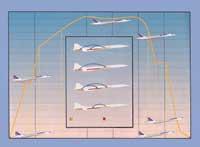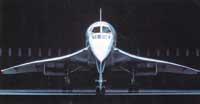Concorde, a plane ahead of the clock
Elhuyar Fundazioa
leave Paris and that same morning (but before, nine
in a few quarters) can be in New York. Three hundred and fifty French companies and two hundred and fifty British companies worked hard and finally, on March 2, 1969, at four in the afternoon, the Concorde was fired for the first time, at five in the afternoon.
They began taking the first steps to fulfill this dream in 1947. Then American Chuck Yeager surpassed the speed of sound with his Bell X-1 plane. Ten years later, the new fighters could move faster than the speed of sound. Since then, aeronautical experts from France and the UK began to think of a special plane. It was going to go twice as fast as the speed of sound, with delta wings and a hundred passengers.

After numerous contacts and programmes, on 29 November 1962 France and the United Kingdom signed the final agreement. The supersonic plane would be built by the French company Sud-Aviation, which in 1970 became Aerospatial, and the British BAC or British Aircraft Corporation. The engines would be the British Olympus, but improved by the French company Snecma and the English Bristol-Siddeley (Rolls-Royce since 1966). To Mach 2, one hundred and twenty people could transport 6,000 kilometers without scales. His name was also chosen: CONCORDE.
Concorde in the air
Three hundred and fifty French companies and two hundred and fifty British companies worked hard and finally, on March 2, 1969, at four in the afternoon, the Concorde was fired for the first time, at five in the afternoon.
Shortly after the
first flight, in March 1970, 002 Concorde surpassed the speed Mach 1. Then on November 4, 001 Concorde reached the speed of Mach 2 (2,200 km/h). The brand was planned for British driver Brian Trushaw, but overheating the plane was carried out by French André Turcat. Other tests were then conducted at Concorde. The following data is summarized:
2 June 1972: 002 He left the Concorde Fairford in England and made a one-month march. It covered 72,000 kilometers, Japan, Australia, etc. visiting.
28 July 1972: Air France requested four Concorde.
26 September 1973: He first crossed the Atlantic at supersonic speed. The tour between Washington and Orly of Paris took place in 3 hours and 33 minutes.
19 October 1973: 001 Last flight from Concorde. After 812 test flights he stayed at the Bourget Museum.
December 6, 1973: first Concorde aircraft of the series took off in Tolosa.
Despite
the big brands, the Concorde aircraft was conceived for use in airlines, and was authorized by the French authorities in 1975. And later the British authorities.
Concorde traveling

The first commercial passenger flight took place on 21 January 1976. Air France used it on the Paris-Dakar-Rio line and British Airways on the Lond-Bahrain line. And soon, on November 22, 1977, Concorde arrived in New York. Flight AF001 departed at 11 a.m. from the Parisian airport of Roissy-Charles de Gaulle and at Kennedy Airport, at nine in the same morning, sat in a few twelve hours and 38 minutes on the air (2 hours and 38 minutes at supersonic speed). After the Air France Concorde, the British Airways landed and both paraded together on the track.
Who travels in Concorde makes a more comfortable journey than conventional aircraft passengers. Time change fatigue is lower and travel pressure, with passengers, is lower than in other aircraft (1,600 meters of altitude and 1,800 meters of altitude unusual). In addition, when circulating at stratospheric altitude there is no wind turmoil and its delta shape for supersonic speed is perfectly suitable.
Some features
Concorde has other features to highlight. The front end bends so the pilot sees the track. The aircraft itself is made of special aluminum alloys and offers you the necessary flexibility. When going to supersonic speed it heats up (up to a maximum of 127 ° C) and with the dilatation it elongates about twenty centimeters.
, the reference for driving the
plane Concorde is temperature and not speed. When the hottest part reaches 127°C, it stops accelerating and the temperature on the outside of the airplane body is 100°C per hour. Therefore, the outside air must cool to enter the cabin (in classic aircraft it is necessary to heat).
Another
feature of Concorde is that it is a burning after burning. The fuel is reinjected into the air so that once the second combustion is finished, the strength of each reactor is 25% higher. When you go at a speed of Mach 2, this equals having five engines instead of four. Fuel also has another function. As speed accelerates, the pumps send the fuel back and forth to change the center of gravity of the plane.
Maintenance and conservation

The aircraft has several advanced security systems. Some are triple to minimize risk. On the other hand, do not forget the periodic inspections carried out by personnel with high level training. Aircraft are reviewed daily and maintenance is performed in 210, 420 and 1,680 hours. After 12,000 hours of flight, a thorough review of the plane is carried out.
Concorde is very high and has no moisture or corrosion. In addition, it is a young plane, as it only makes a trip of 600 hours a year (Boeing or Airbus make 3,000 hours a year).
Paris to New York City Tour
Let's get into Concorde's cockpit and see the behavior of the world's most advanced civilian aircraft. Concorde weighs 90 tons with 100 passengers inside. The journey starts with 96 tons of fuel to travel from Paris to New York. A total of 186 tons. After taking advantage of the power of its four Olympus 593 engines at takeoff, the device weighs a total of 185 tons. The plane must burn a ton of kerosene to go to the end of the parking lot takeoff track. When he then accelerates on the track and reaches a speed of 370 km/h, he leans up and takes off. Run on track a mile and a half in thirty seconds. Thirty seconds after takeoff, the second combustion is cut and rises the previous end. Then climb 2,000 feet per minute (about 600 meters).
At nineteen minutes of takeoff it has an altitude of 7,700 meters and from there Concorde is not like a conventional plane. It reaches supersonic speed, but in the change from subsonic to supersonic the center of the plane changes.
The center of gravity of the apparatus is delayed by pumping the fuel back from the previous tanks. When passing to Mach 1 the second combustion is lit and when it reaches 9,000 meters of altitude a trip of 300 kilometers is made in twenty-eight minutes.
Then Concorde accelerates and in six minutes passes from Mach 1 to Mach 1.7, reaching a speed of 13,000 meters. The second combustion goes out and in the next twenty-five minutes the plane arrives at Mach 2, an hour after takeoff.
With
1,225 kilometers of travel starts at more than 15,300 meters and travels at altitudes between 16,000-18,000 meters. The external temperature is -55 °C, but due to kinetic heating the plane reaches 120 °C. After 2 hours and 40 minutes of departure, it has traveled 5,385 kilometers. There are 600 kilometers to JFK New York Airport. In nine minutes it drops from 2,02 Mr (2,200 km/h) to 1 Mach. When the speed is Mach 1.6, the fuel is pumped from behind. At 10,700 meters altitude it has a speed of Mach 1 and is located at the height of Boston. Seven minutes ago at a constant altitude of 10,700 meters, at an approximate speed of Mach 0.95. In another sixteen minutes Concorde loses more than 9,000 meters. They lower the front end of the plane and land in twelve minutes in New York. At 293 km/h it falls to 275 km/h and is pruned on the ground with a flight of 3 hours and 30 minutes.





